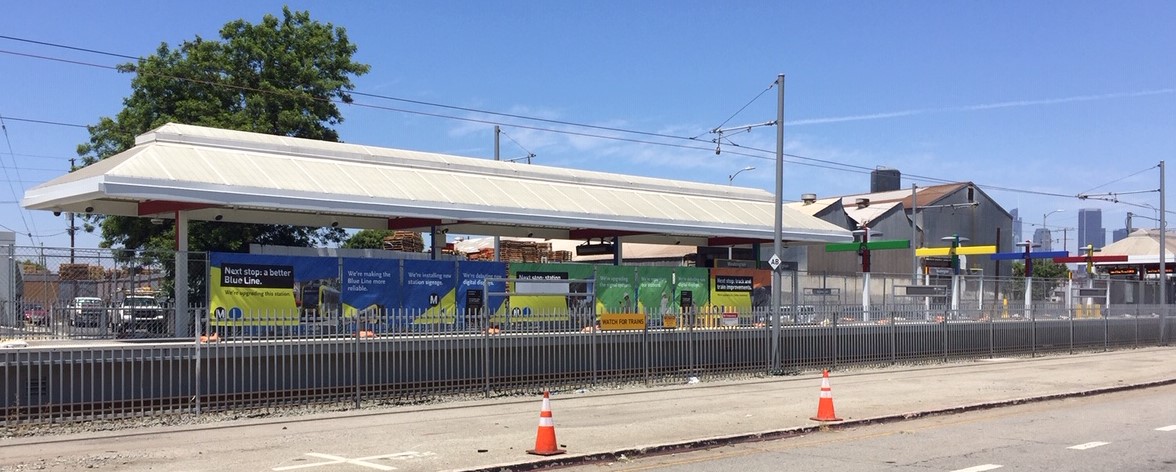Until this morning, Metro was expected to re-open the Blue Line in "late September," as the agency had announced in late 2018. Today, Metro announced that the re-opening is delayed by a month, and will now be "late October."
Portions of Metro's oldest rail line have been closed since January under the agency's "New Blue" rehabilitation project. Metro has been doing $350 million worth of modernization designed to “enhance safety, increase reliability, and improve the customer experience.” The project includes replacing tracks, upgrading train control and overhead power systems, adding four new crossover tracks/switches, and giving Willowbrook/Rosa Parks Station a major upgrade.
During closures, Metro has been running shuttle buses. With more than half a year of partial closures and shuttles, the corridor's ridership has declined. Last year, the Blue Line typically saw 60,000+ weekday riders. As of July, rail and shuttle ridership combined for ~43,000 total daily riders. Every weekday, about 17,000 former riders shifted their trips elsewhere - likely some to parallel Metro buses, some to cars, and some not making discretionary trips.
In May, during New Blue closures, the Metro board voted to cut peak Blue Line train frequencies from 6 minutes to 8 minutes, reducing rush hour service by 25%. Identical Expo Line service cuts resulted in today's crowding. The Blue Line is likely to experience similar crowding when it re-opens.
Reading Metro's announcement today, the word "delay" does not appear. The announcement doesn't even state that the opening date changed from September to October. Metro states, "Thank you for your patience as we enter the home stretch of the New Blue Improvements Project...." and "Metro would like to extend our sincerest thanks to our riders for their patience during the service closures and construction." Metro further announces:
Metro will celebrate the line’s reopening and thank the public for its patience with free rides and a local community celebration. The exact opening date and details of the celebration will be announced next month following train testing.
Sure, it is Metro's job to try to put a positive spin on this. But why not acknowledge that the date has changed? Why not tell riders what caused the delay? Construction delays are common on big infrastructure projects - from freeways to rail lines. There is no need to act as if the delay never happened. These Blue Line refurbishment and Rosa Parks station upgrades are needed. The New Blue will result in better and more reliable service.
If Metro really wants to thank its riders for their "patience," then they should be upfront about construction delays. Riders deserve the truth.
Rather than spending time and money celebrating, how about instead restoring cut service? Riders won't need to keep being so patient, if the Metro Board would act to return service to the 6-minute headways that Blue Line riders were accustomed to when closures got underway in January. In addition to needed frequent peak-hour service, Metro should improve off-peak service, too. In 2016, the agency cut evening service in half, increasing headways from 10 to 20 minutes.
In Long Beach, some signal prioritization was added as part of New Blue - but too often Blue and Expo Line trains slow excessively in stretches where they wait in mixed traffic with cars. Metro should work with cities (including traffic enforcement departments) to continuously improve Blue and Expo train prioritization over car traffic. Single-occupancy vehicles should not have priority over trains carrying hundreds. In 2017, Phil Washington pledged to shave 10 minutes off the Blue Line's end-to-end then-58-minute trip time. Metro needs to redouble its efforts to make good on Washington's pledge - and strong effective signal prioritization is one part of the solution.
Lastly, Metro should acknowledge that, more than any other Metro rail, the Blue Line serves many disenfranchised neighborhoods. Rather than platitudes about so-called "choice riders," Metro should recommit to serving the Blue Line's core South L.A. ridership. Prioritizing equity would take a multi-faceted approach, including commitments to:
- change practices that criminalize riders, especially young Black and Latino men
- find ways to work with vendors, instead of criminalizing and ostracizing them
- increase homeless outreach services
If Metro puts its riders first - in honesty, in service frequency, in speed and prioritization, in equity - this would be worth celebrating!







